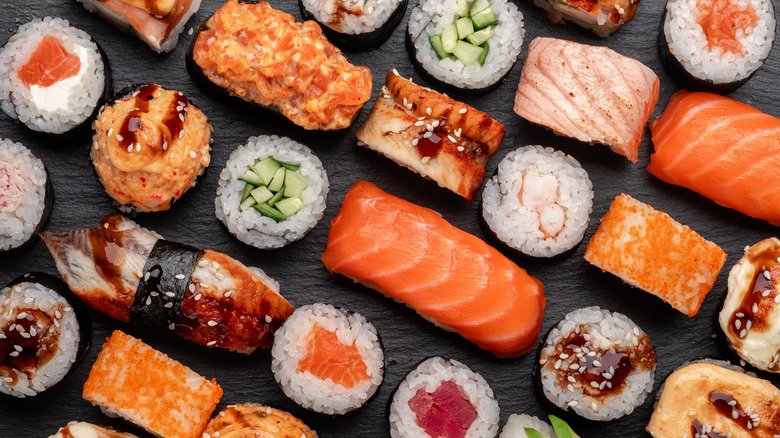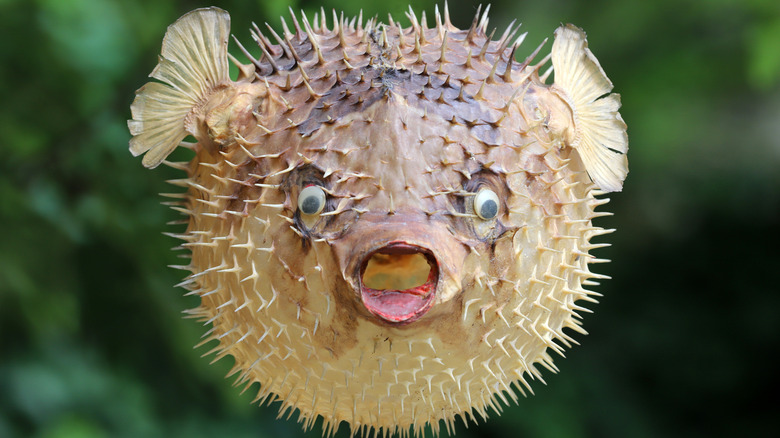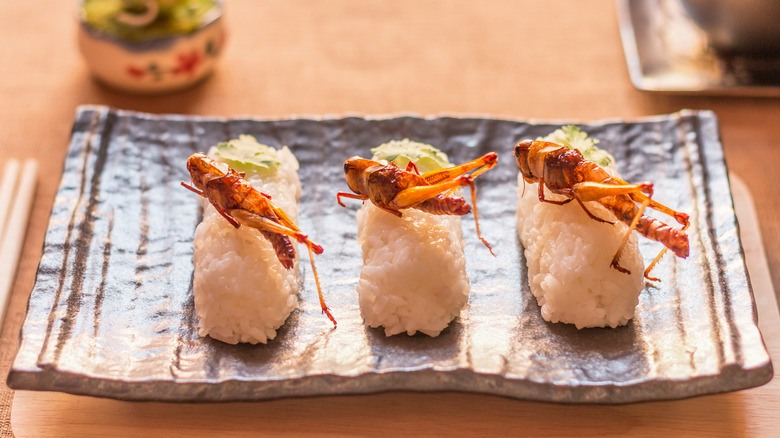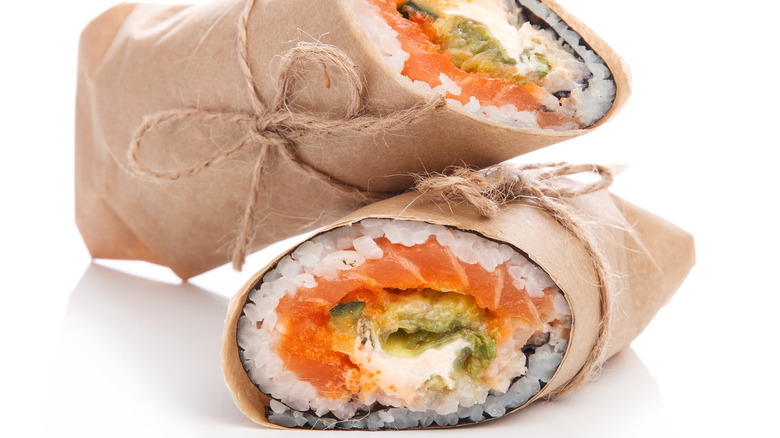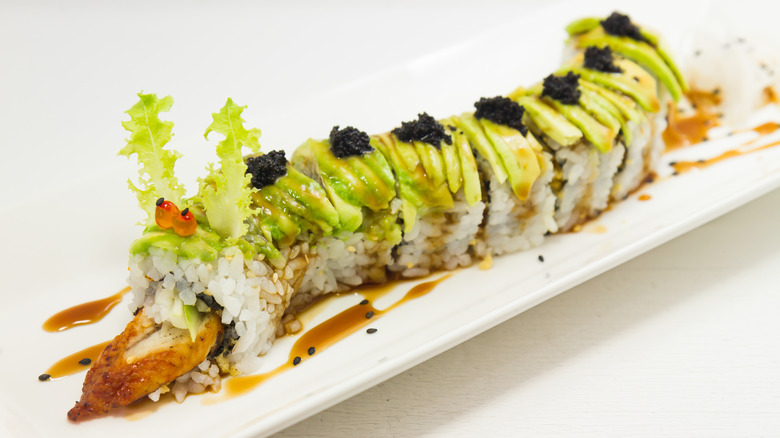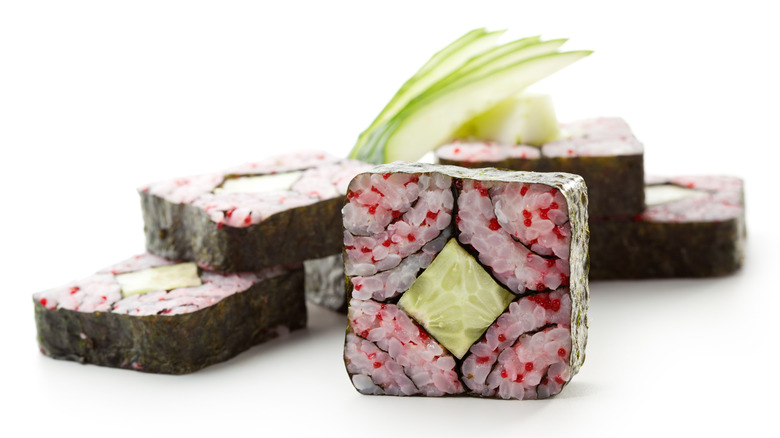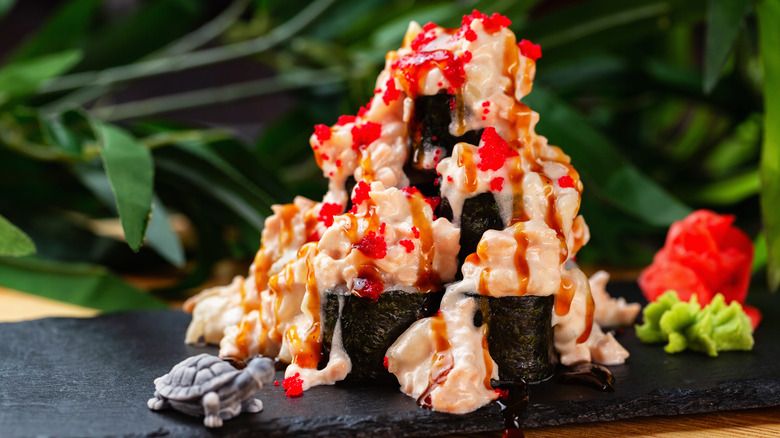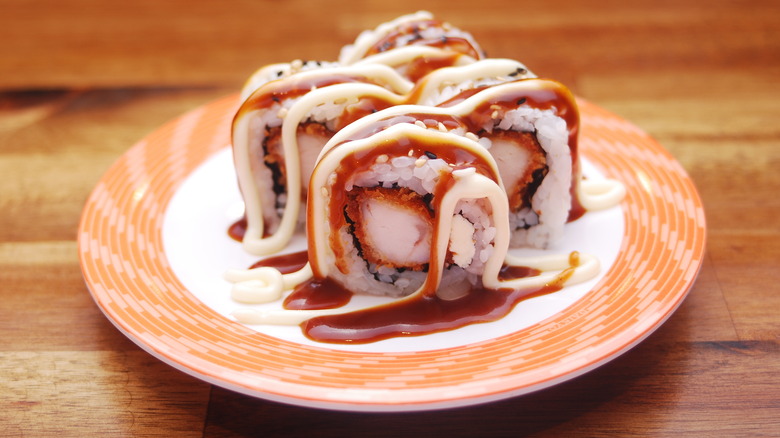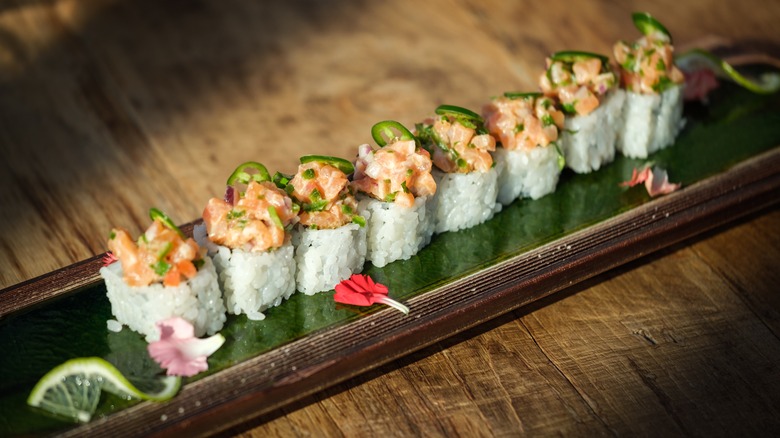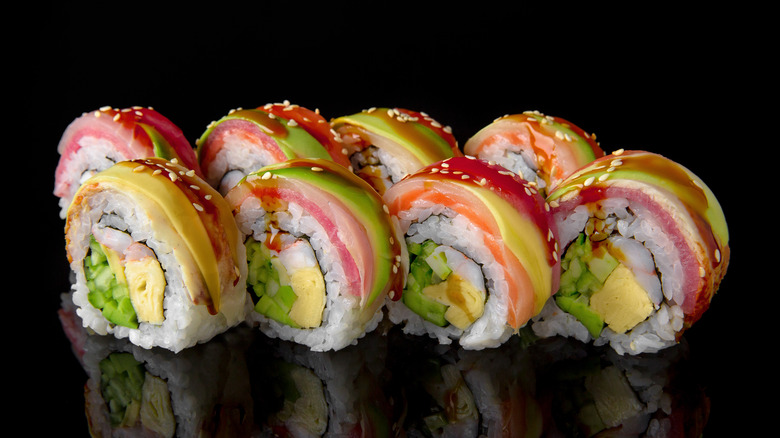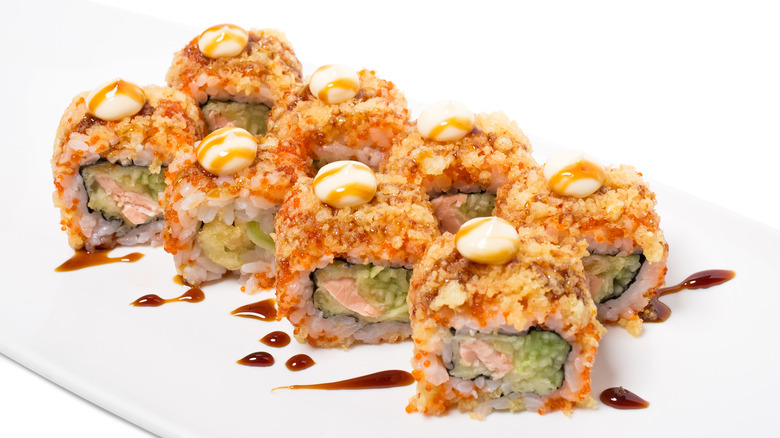10 Types Of Sushi And What Makes Them Unique
All cooking is a form of art, but sushi takes the craft to another level. With just a handful of fresh ingredients like freshly steamed rice, raw tuna, salmon, and crab, sushi chefs can quickly yet delicately prepare everything from nigiri to sashimi to maki rolls. By mixing and matching various cuts of raw or fried seafood with other simple ingredients like green onions, cucumber, wasabi, spicy mayo, and eel sauce, talented chefs create dozens of different sushi dishes with their own distinct flavor profiles.
According to Food 52, sushi was originally sold as street food in Japan around the 8th century. After entering the American market in the 1950s and '60s, sushi has grown increasingly popular in recent years, expanding into nearly 16,000 sushi restaurants across the country (via Ibis World). When you visit one of these sushi restaurants, you're likely to see a lot of the classics: spicy tuna, salmon nigiri, and shrimp tempura rolls, among others. But these days, there are some more interesting twists of this ancient dish being offered, too. Here are 10 types of sushi and what makes them unique.
Blowfish sushi
Most people aren't willing to roll the dice on a potentially poisonous meal, but that's exactly what fish-starved daredevils do every day when they eat blowfish sushi, also known as puffer fish, porcupine fish, or fugu (via Sushi FAQ). The reason blowfish sushi can be potentially fatal is because of the lethal toxin found in its organs. If the blowfish isn't prepared carefully enough, these toxins can bleed out from its organs and contaminate the meat of the fish.
When consumed, the toxin leads to numbness around the mouth, spreading paralysis, and can quickly turn fatal (via BBC). Because of its potential for death, sushi chefs are required get a special license to prepare blowfish, which is a process that can take up to two years and also involves a test. When prepared correctly, raw blowfish meat has a light taste that is also uniquely crunchy (via Food in Japan). It's definitely not everyday you encounter a dish that can be more poisonous than cyanide.
Insect sushi
The last thing most people want to do is pay money to eat bugs. But the reality is that throughout most of our history and still today in cultures across Africa, Asia, and Latin America, humans have relied on eating bugs for survival (via National Geographic). Still, for many, even just the thought of chowing down on some creepy-crawlies is probably enough to trigger serious anxiety (via Healthline). Yet there are plenty of dishes out there that feature insects including wax worm paella, chips made from ground up crickets, mealworm smoothies, and even insect sushi.
Insect sushi contains fried insects such as grasshoppers, scorpions, and mealworms (via Nonilo). What makes insect sushi so extraordinary is not only how rare it is to see on a menu in the Western hemisphere, but also how nutritious it is. Researchers at Oxford University found that crickets have more protein and vitamins than any other meat (via Shape). According to Science Direct, some analysts believe that insects could reduce famine worldwide and will eventually become a bigger part of our diets due to their high protein and sustainability.
Sushi burrito
Mexican food and Japanese cuisine don't exactly go hand-in-hand. Sure, they share some common features, as all cooking does on some level, but in terms of their typical ingredients and flavor profiles, they're about as polar opposite as it comes. Yet somewhere along the way, a former investment banker named Peter Yen got the bright idea to combine the humble sushi roll with the generously-sized burrito, and perfected the concept, leading to the opening of Sushirrito in San Francisco. Sushi burritos are a trend that can now be found in food trucks and fusion restaurants across the country (via Washington Post).
The concept is a simple one: Take a roll of sushi but make it bigger so that it can be eaten handheld, just like a burrito. It's not just the size of the sushi burrito that makes it unique. Some of the flavor combinations are also quite special. The creation of ginger guacamole, for example, perfectly fuses two culinary traditions.
Caterpillar roll
For the sake of everyone's appetite, restaurants don't normally want diners thinking about insects, let alone make an effort to create dishes that actually resemble them. (Unless, of course, they're serving one of the aforementioned insect dishes.) Yet the caterpillar roll manages to embody its namesake with eerie accuracy while not actually containing caterpillar — the ingredients and presentation give it the appearance of one.
By fanning out thin slices of avocado on top of the roll, sushi chefs create the illusion of a caterpillar's green exoskeleton (via Izzy Cooking). The roll is often arranged on the plate in a meandering pose to mimic the wiggle of the insect's movement. Like many sushi dishes, there are regional variations of the caterpillar roll, but common ingredients include eel, shrimp tempura, cucumber, and eel sauce (via Secrets of Sushi). The insectile appearance of the caterpillar roll, along with the massive amount of avocado layered on top, make it a truly unique sushi dish.
Mosaic sushi
There's something inherently beautiful about sushi. Your eyes can't help but soak in the vivid color contrast between blood red tuna against the stark white steamed rice. The glimmer of orangish pink salmon tucked beside a bright green slice of fresh avocado is a sight to behold. With just a few ingredients, sushi manages to not only be delicious and healthy, but also an exquisite form of culinary eye candy.
Mosaic sushi accentuates sushi's colorful allure even more. By carefully and symmetrically arranging multicolored ingredients, mosaic sushi rolls produce a beautiful geometric pattern that look almost kaleidoscopic. This effect can be produced in part by using different colors of rice — one method infuses fresh raspberry juice to naturally stain the grains a vibrant pink. Mosaic sushi rolls are often formed into long rectangles instead of the traditional cylinders. When cut, this shapes each piece of the sushi roll into a square, which helps it develop the elegant appearance of a mosaic tile.
Volcano roll
We normally do our best to steer clear of exploding volcanoes, but somewhere along the way, we also decided it would be fun to make sushi that looks like it's spewing lava onto our dinner plate. Enter the volcano roll, a dish that's often featured on the menu at many sushi restaurants.
There are several variations of the volcano roll, but the unifying characteristic is that sushi is carefully arranged on the plate to mimic a volcanic eruption. This is almost always accomplished by stacking the sushi rolls into a cone-like shape and drizzling streams of spicy mayo from the sushi roll. To add more depth of color, orangish red masago can be sprinkled on top of the spicy mayo to create a shade of crimson. Other ingredients typically include spicy tuna, crab, cucumber, and avocado. What really sets this sushi dish apart from the rest is its unique arrangement on the plate and its higher level of heat, which comes from an avalanche of spicy mayo.
Katsu sushi
When most people think of sushi, they probably imagine tender strips of raw fish. And while that's usually the case, it's also true that some sushi dishes feature cooked meat, such as katsu sushi. Katsu is a Japanese dish that features a chicken or pork cutlet that is breaded, fried golden brown, and drizzled with a sweet and savory dark sauce (via Serious Eats). Katsu is usually served with a side of finely shredded cabbage and steamed white rice, and is considered a comfort food in Japan.
These days, katsu is also featured on some sushi roll menus. Thin strips of breaded and fried chicken or pork are placed on top of white sushi rice and then lightly basted in katsu sauce, capturing the essence of the traditional dish in sushi form. There are a few things that make katsu sushi unique: the complex flavor profile of the sauce, which isn't something that you'll see used anywhere else on a sushi menu, and the fact that it seamlessly blends two Japanese dishes into one.
Firecracker roll
Sushi isn't really known for being a particularly fiery dish. Sure, wasabi plays a role and imparts its own unique sparkle of spice, but proper sushi etiquette typically requests that diners use wasabi sparingly. The reasoning for this is that while wasabi can bring out the flavors of the fish, using too much can overpower it, and appreciating the taste of fish is the main purpose of eating sushi (via Cobo Sushi).
The firecracker roll throws all of that out the window and proudly puts the heat in the spotlight. Spicy tuna, yellowtail, cucumber, and avocado are rolled up in nori paper and sliced — then each piece of sushi is topped with a thin slice of fresh jalapeño (via Secrets of Sushi). The addition of fresh jalapeño to this sushi dish makes the firecracker roll one of the spiciest types of sushi offered at most sushi restaurants. The heat of the jalapeño may be a bit overbearing for those less initiated to the Scoville scale, but the gentle warmth and slight crunch of the pepper join forces with the other flavors in a delightfully surprising way. All in all, the firecracker roll is a distinctive example of a tasty modern twist on a traditional dish.
Rainbow roll
Sushi is usually quite vibrant, but the rainbow roll really cranks the colors up. This is accomplished by layering different colors of fish on the outside of the sushi roll in an assembly style that's sometimes referred to as an "inside-out" roll but is technically called a uramaki roll. By placing alternating colors of raw fish and other ingredients on the outside of the roll, the colors pop much more than they would tucked away on the inside, creating a bright spectrum of beautiful color contrasts (via Izzy Cooking).
Some common ingredients in the rainbow roll include salmon, tuna, avocado, and mango (via Masala Herb). Not only is the rainbow roll special for its gorgeous color scheme, but also for its use of mango, which is rarely used in other sushi rolls. The unique taste of mango pairs very nicely with the fish and avocado, creating an almost tropical flavor profile that's truly extraordinary.
Crunch roll
Between the steamed rice and tender fish, most sushi rolls have a relatively soft and smooth texture that melts in your mouth like butter. The crunch roll is unique in how it provides a stark contrast to that typical softness by featuring a crispy exterior through the use of brittle panko breadcrumbs (via Izzy Cooking). The panko breadcrumbs provide a crunchy balance to the mouthfeel of the roll, which is a nice change in texture from more traditional sushi dishes.
Some other common ingredients in the crunch roll include shrimp tempura, avocado, cucumber, and shredded crab meat. Between the fried shrimp tempura, crispy cucumber, and a generous dusting of panko bread crumbs, the crunch roll lives up to the promise of its name. The crunch roll is a unique option for all sushi lovers and can be a refreshing way to provide some textural contrast to supplement the softer sushi dishes on your plate.
